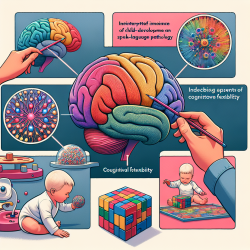Introduction
In the realm of child development, understanding the intricate processes of brain maturation is crucial for practitioners aiming to enhance therapeutic outcomes. The recent research article, Implications of Extended Inhibitory Neuron Development, sheds light on the prolonged development of GABAergic interneurons, which play a pivotal role in cognitive flexibility and neural circuit formation. This blog delves into the implications of this research, offering insights for practitioners to refine their approaches and encouraging further exploration into this fascinating area.
The Role of GABAergic Interneurons
GABAergic interneurons, although constituting only about 20% of the neuronal population, are integral to the brain's functional connectivity. These neurons are responsible for maintaining the delicate balance of excitatory and inhibitory signals, crucial for cognitive processes and sensory discrimination. The extended timeline of their development, particularly in larger, gyrencephalic brains like those of humans, suggests a heightened capacity for cognitive flexibility and environmental adaptability.
Key Findings from the Research
- Protracted Development: The study highlights that the development of GABAergic interneurons extends well into the postnatal period, allowing for greater environmental interaction and neural plasticity.
- Environmental Influence: The prolonged development period provides a window for environmental factors to shape neural circuits, potentially impacting cognitive outcomes.
- Therapeutic Implications: Understanding these developmental processes can inform targeted interventions for neurodevelopmental disorders, enhancing therapeutic efficacy.
Practical Applications for Practitioners
For speech-language pathologists and other child development professionals, integrating the insights from this research can lead to more effective intervention strategies. Here are some ways practitioners can apply these findings:
- Early Intervention: Recognize the critical periods of inhibitory neuron development and tailor interventions to coincide with these windows of heightened plasticity.
- Environmental Enrichment: Create environments that stimulate cognitive and sensory development, leveraging the brain's plasticity during the extended development phase.
- Individualized Approaches: Use data-driven assessments to identify specific developmental needs and customize interventions accordingly.
Encouraging Further Research
The findings from this research underscore the importance of continued exploration into the development of inhibitory neurons. By expanding our understanding of these processes, we can uncover new therapeutic avenues and improve outcomes for children with neurodevelopmental challenges. Practitioners are encouraged to stay informed about ongoing research and consider collaborative efforts to advance the field.
Conclusion
The extended development of GABAergic interneurons presents a unique opportunity to enhance cognitive and developmental outcomes in children. By applying the insights from this research, practitioners can refine their approaches and contribute to the growing body of knowledge in child development. For those interested in delving deeper into the original research, the full paper can be accessed here.










